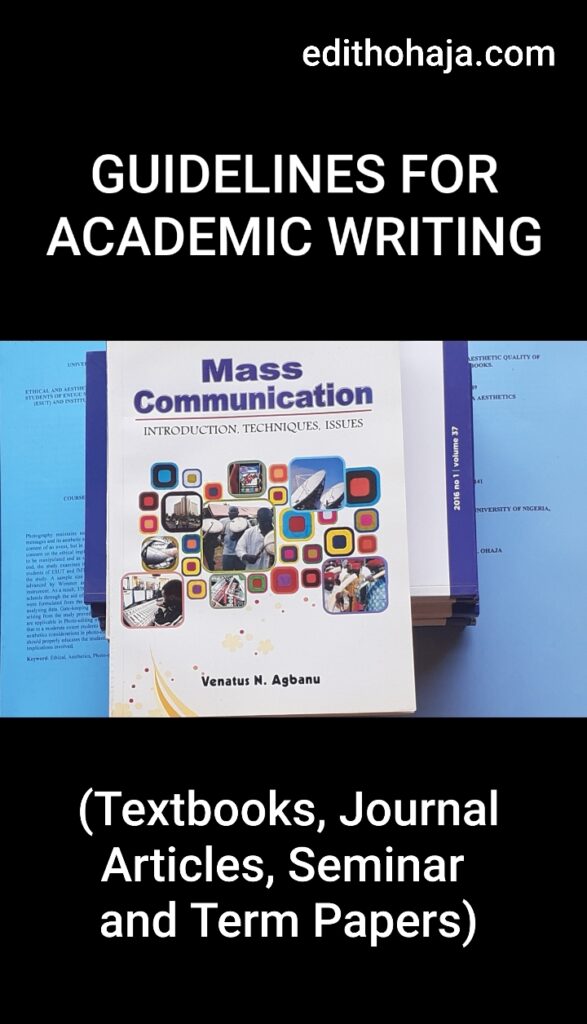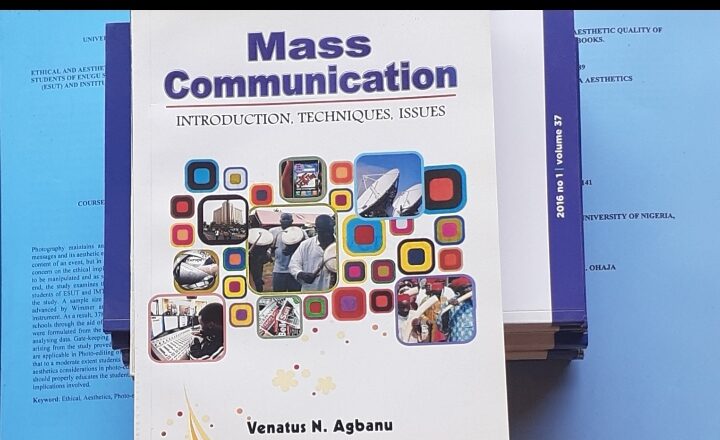GUIDELINES FOR ACADEMIC WRITING: Textbooks, Journal Articles, Seminar and Term Papers
Introduction:
Different kinds of writing have different conventions. Informal writing is approached in a different manner from formal writing. This post focuses on academic or scholarly writing, which is part of formal writing. It discusses key points to bear in mind when doing scholarly writing like textbooks; journal articles; conference, seminar and term papers.
Although creative writing can be done for academic purposes, some of these guidelines do not apply to such works as poetry, fiction, nonfiction and the like as they often require a personal and informal approach. The same applies to some forms of journalistic writing like soft news, reviews and personal experience features.
However, intellectual pieces that discuss the aforementioned forms of creative and journalistic writing need to apply the guidelines in this post.
A few related posts that amplify some of the points in this article, like the matter of style and other issues to consider when writing a publishable work, are linked within and at the end of it.
Guidelines for Academic Writing
- Do not use contractions
Contractions like “don’t,” “won’t” and “hasn’t” are more appropriate in informal writing. Use the full form of these terms when writing a scholarly piece.
- Use the terminology for your field
Every field has its own terminology or jargon. You need to read widely in your field to familiarise yourself with the jargon and use it for your scholarly writing. Using everyday language to couch your work rather than applying the specialised terms in your field is wrong. It will limit the value of your work because some terms from everyday language mean different things in your field. Your work will thus lack the precision and rigour required in scholarly writing.
- Conform to the style guideline on how to refer to yourself
Many academics do not use the singular first person pronoun “I” to refer to themselves in their works. Some say it sounds informal and arrogant, others say it is distracting. As a result, they use the plural form, “We,” even in sole-author works. Others use the third person, “the author,” “he or she,” to refer to themselves. But there are some who use “I”.
The various options above are allowed by different publications. Authors need to confirm the style guidelines for the publications or institutions their works are meant for and conform to them. They can make their own decisions if the works are to be self-published.
- Use the present tense for attribution
When you cite previous works, it is the norm to use the present tense as this example shows:
“In his Theory of …, X describes human beings as capable of reason and self-control” (X, 2015).
The exception to this rule would be when the sentence refers to the past as in the following case: “In 2015, X formulated a Theory of … in which he described human beings as capable of reason and self-control.”
- Be concise
Every word you include in your writing must contribute to accomplishing the purpose of the work. Therefore, verbosity is discouraged. It not only makes your work unnecessarily long, it weakens its power.
- Avoid verbatim repetition
It is irritating to see the same sentences and passages repeated all over your work. It gives the impression that you are just copying and pasting material to fill up space because you do not have a good grasp of the topic or you did not do sufficient research to find relevant material on it.
If you must repeat an idea for emphasis or as a prelude to a broader point you want to make, rephrase it slightly.
- Stick to one form of spelling – British or American
Do not alternate between the two. Always check your work to harmonise the spellings in case your computer autocorrected some to the wrong language.
- Avoid plagiarism
Plagiarism is so common these days that many are unaware that it is a grave academic offence with stiff penalties.
A lot of students and lecturers are even ignorant of what constitutes plagiarism and how to avoid it in their writing.
A comprehensive discourse of the foregoing is available in this post:
https://edithohaja.com/what-is-plagiarism-its-penalties-and-how-to-shun-it/
- Avoid pretentiousness
Do not use your language to bamboozle. Stringing together polysyllabic words does not make you a respected author if you fail to communicate.
- Be specific
Do not couch your work in vague language. If you want to address frequency of, say, TV viewing, rather than use terms like “often,” “sometimes” and “rarely,” use more specific terms like “daily,” “few days a week,” “once a week,” etc. For magnitude of TV viewing, instead of saying, “heavy viewing” and “light viewing,” supply a range of hours of TV viewing that will give a clearer picture of what you describe as heavy or light viewing.

- Be orderly in your presentation
There is an expected order for presenting material in scholarly writing. For example, the goals of a study captured in its Objectives, Research Questions or Hypotheses should be presented before addressing the Methodology. The findings of the study should address these goals earlier stated.
Illustrations like tables and figures should be presented before the data in them are discussed and they should have titles. The titles for tables are usually above them while those for figures are normally placed under them.
Present material in logical sequence. For instance, merits should come before demerits and if explanations of ideas or individuals are needed, they should come in the order they were first mentioned.
Instead of dropping ideas haphazardly in your work, use a chronological order or arrange the ideas according to their similarity or dissimilarity with the other ideas raised. In the latter case, you can discuss the similar ideas before introducing the opposing ones, instead of jumping back and forth between the two.
In any case, let their be orderliness in your presentation.
- Sound objective
Avoid sentiments, categorical assertions without evidence and activism. Scholarly writing should not be used as a soap box to sell your race, religion, ethnic group or political party.
Cite sources to back up important assertions, even if you coined them. Do not make wild accusations. Rather, make your postulations, present the data and discuss your findings in relation to the findings of similar research.
In view of this, the practice in social science research is to say that the data “suggests that,” “it appears that Variable A has a significant influence on Variable B,” “Variable A tends to correlate with Variable B.” Words like “likely” and “probably” are also used. For example, you seek to determine the likely causes and the likely consequences of an incident.
- Use surnames to refer to your sources
In citing someone, you can say Ukonu (2022). If you need to add more information about the source, you can say, “the former News Editor of The Guardian newspaper, Marcel Mbamalu, once emphasised the importance of writing skills for the mass communicator in these words, ‘….”’ (Mbamalu, 2020). Any further reference to him should be with his surname.
- Be thorough
Proofread your work over and over, not only to remove language errors but to ensure that you have included all the sources cited in the work in your References with their full and accurate documentation details. Avoid a situation where authors’ name are spelt in different ways in your work, their first names are used in place of their surnames and the dates for the same book cited vary.
Conclusion
I hope you have found the guidelines discussed above helpful. Be sure to look at the material linked and drop any questions you have on this topic in the Comments below.
HERE ARE SOME RELATED POSTS:
5 Points to Consider before Submitting an Article
7 GUIDELINES FOR FAITH AND INSPIRATIONAL WRITING (What to Avoid)
Writing is Central to Every Area of Mass Communication


This is lovely. Thanks mum for this platform.
God bless you for sharing.
God bless you too!
This makes things a lot easier😩, thank you ma🤲
You’re welcome!
This is the first time I am familiar with the names cited in a work of art.
I feel at home 😊
This is beginning to make sense.
Ahhh… God bless you ma.
God bless you too!
This article will be of great help to me. Especially now that I’ll be writing my print seminar and project. God bless you ma’am
God bless you too!
Thanks for the guidelines ma
They’re really helpful.
Thank for so much for this article, especially now that I will be doing journal, seminar and project writing. Thank you, ma’am!
Thank you Ma for these guidelines.
Please, how can a writer cite sources to back up important assertion if he is the one that coined it at that point of writing his article?
If I understand you correctly, you want to give scholarly backing to your assertion, so there’s nothing special about the citation. Learn about the APA Style which is used in our department and other social sciences.
Thank you so much ma’am for this guidelines.
This content truly provides valuable guidelines for academic writing. It emphasizes the importance of adhering to formal writing conventions and the need for precision and clarity in scholarly works. The points on using field-specific terminology, avoiding contractions, and maintaining an objective tone are particularly relevant. It’s a useful resource for anyone engaged in academic or scholarly writing.
Writing guidelines are super helpful! It provides valuable insights on how to write effectively for textbooks, journal articles, seminar papers, and term papers. It’s important to follow these guidelines to ensure our academic work is well-structured, properly referenced, and credible.
Your writing is clear and concise, and you provide helpful examples and tips throughout the post. Thank you ma
Waw this piece took me back to secondary school days. I was taught literary devices and I can see it’s relevant in feature writing as well. God bless you ma
Wrong post. You must have meant to comment on a post about feature writing.